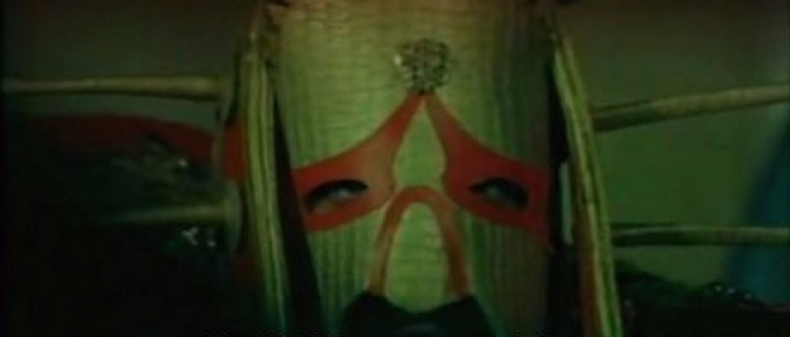
In Flying Saucers Over Hollywood, a 1992 documentary about Ed Wood, author Brad Linaweaver argues that criticizing the cut-rate special effects in Wood’s Plan 9 from Outer Space (1959) misses the point. Sure, the film’s “flying saucers” are clearly just dollar-store model kits suspended by string, but we should approach these images with a more charitable spirit. “Ed Wood invented symbolic effects to take the place of special effects,” says Linaweaver. “When he wants a special effect, he puts a symbol on the screen of the special effect he would have if he had the money.”
Dünyayı Kurtaran Adam (The Man Who Saved the World, 1982) takes this kind of symbolic spectacle a step further. More commonly known as “Turkish Star Wars” — a bootleg title both bluntly functional and touchingly delusional — the film is a shameless pastiche in the style of George Lucas that creates an elaborate science-fiction universe entirely predicated on our knowledge of other science-fiction universes. Generously padded with “borrowed” special effects from the original Star Wars and music from Raiders of the Lost Ark, everything in Turkish Star Wars — its bland heroes, its simplistic villains, its sketchy mis-en-scene – requires memories of the real Star Wars to fill in the blanks. If Ed Wood’s flying saucers were a symbol of a better special effect, then Turkish Star Wars is a 90-minute signifier for a better film — one that might have existed if Turkey’s circa-1982 film industry had had the money, and perhaps the George Lucas, to pull it off.
But what it may lack in clarity or originality, Turkish Star Wars makes up for in sheer denseness. In the opening scene, an omniscient narrator unloads a torrent of exposition while we see a montage of random Star Wars special effects footage, some shots repeated four or five times. Centuries in the future, long after the space race has made interplanetary travel a daily reality, all earthly nationalities have united as a single race. A few seconds later, this entire premise is contradicted when the narrator adds that nuclear armament has escalated at an alarming rate, and “two Turkish warriors and other humans sailed into space and declared war to the unknown enemy.”
This unknown enemy — a 1,000-year-old wizard exiled from earth, part Darth Vader, part Ming the Merciless — has been trying to destroy our planet for centuries. Time and time again, he has been foiled by what the narrator calls “a coating which was formed by compressed human brain molecules protecting the earth. Earth was turning into a dust cloud under every attack and was hiding behind the protecting shield.” (The “shield” is actually the Death Star, seen in archival footage). The wizard hopes to finally break through this orb-shaped “shield” by harnessing the power of the human brain, and it’s up to two Turkish adventurers to stop him.
After a brief space battle (in which the stock-footage Millennium Falcon is destroyed twice), our heroes find themselves stranded on a Dagobah-type desert planet, where they encounter a nonstop onslaught of the wizard’s henchmen, mostly stuntmen in huge papier-mché masks of the Mardi Gras variety (sometimes they stick their heads into the camera very suddenly). In this film’s low-budget equivalent of the Cantina scene, one hero engages in a rousing martial arts fight with a red plush alien, and eventually chops off its arm for use as a weapon. Such violence might seem unwatchably brutal in any other film, but it passes by very quickly here.
All this description only scratches the surface of this cinematic Mobius strip. Almost every minute brings new complications, new space creatures, new fight scenes, new plot twists, new training montages. With its impenetrable plot, dense web of allusions, and free-form approach to the very basics of film grammar, Turkish Star Wars is the idiot-savant The Holy Mountain — the Finnegans Wake of crap. It has nary a dull moment, although by the midpoint you may find yourself longing for a few. It sometimes feels like eating twelve pixie sticks and calling it dinner.
The best bad movies, like Ed Wood’s Glen or Glenda or Tommy Wiseau’s The Room, have a personal edge that gives them a tragic dimension. Turkish Star Wars isn’t really an auteurist work, but it does offer a melancholy window into the era that produced it. It arrived in the midst of a slew of Turkish rip-offs of American blockbusters, including Rambo, The Wizard of Oz, Star Trek, Superman, The Exorcist, Rambo, E.T., and even Young Frankenstein, which was remade scene-by-scene as a straight horror film. In Turkish Star Wars, there are a few nationalistic touches here and there (the narration makes a point of identifying the heroes as Turkish, and there’s a bizarre interlude where we learn that the planet’s downfall came from abandoning Islamic religion), but as with the other Turkish rip-offs, it generally gives the impression of wanting to be a mass-market spectacle in the Hollywood tradition. Over and over, this movie keeps tilting at windmills, and losing.
And despite everything, there was a happy ending for this pitiable little film. Over the years, it became enough of an underground hit that most of the cast was reunited in 2006 for a sequel, Son of the Man who Saved the World (aka Turks In Space). It may have taken 24 years, but somehow, Turkish Star Wars really did become a franchise.
Turkish Star Wars will screen at the Projection Booth Theatre at 9 pm on May 4, 2012.











